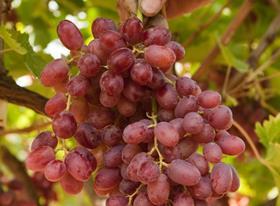
For Greek grape producers, much of the focus at present is on new varieties, but confidence surrounding Greece’s most common variety, Crimson Seedless, also remains high for the coming season.
“The feeling is that it will be a good campaign in terms of volumes,” said Antonis Ioannidis, quality control manager at Zeus Kiwi. “At the moment we are concentrating on Crimson, but we are experimenting with some new varieties, which we hope to introduce to our growers.”
Many of the exporter’s new grape growers have been persuaded to invest in production, revealed Ioannidis. “Some are using plastic covers to protect their fruit to enable us to supply later in the season,” he said. “Late October to mid-December is the best window for our grapes, as Spanish production dominates until late-October, while Italy are right at the end of their season at this time.”
George Kallitsis of Protofanousi Fruits expects a normal Crimson Seedless crop this season, but he too stressed the efforts being made in terms of new varieties.
“We have already started trials with UK company Jupiter to plant new varieties,” he said, “including the white Arra 15 and the red Arra 19 and Arra 32, plus a black variety from Chile called Inia One. The aim is to find alternatives to Crimson Seedless, with the right colour, better yields and better storage potential. The Arra 15 is a good possible alternative to Thompson Seedless, but it is more suitable to production in the north of Greece instead of the south. We therefore hope for better yields, but this variety has never been planted in Greece before. If successful, we want to increase plantings of all these new varieties.”
For Greek grape exporters, Europe remains the number one market, with the UK, the Netherlands, Germany and Scandinavia key destinations. However, question markets surround the UK market in the wake of last year’s Brexit vote.
“As long as it remains an open market, everything will be fine,” said Ioannidis. “The drop in the value of the pound really affected last year’s grape campaign to the UK, but it’s too early to say for this season. Clearly it will take a couple of years to see what the negotiations will bring. There’s no previous experience of a country leaving the EU.”
Protofanousi Fruits produced some 700 tonnes last season, a volume that it expects to boost to over 1,000 tonnes this year. In addition to Europe, the exporter is also looking at East Asia and the Middle East.
“Maybe Greece will arrange a protocol to send direct to the Chinese market before the season starts, but we are not optimistic,” said Kallitsis. “Such deals are not easy to complete, and China has a lot of local production of Crimson grapes, making it tough to compete on the market. If there is a protocol in place, we will send some trial shipments, maybe mixed with kiwifruit volumes. The Middle East is another option, but it is not a very stable market, with demand varying from year to year and focused mainly on white grapes. So we prefer to concentrate on Europe.”



